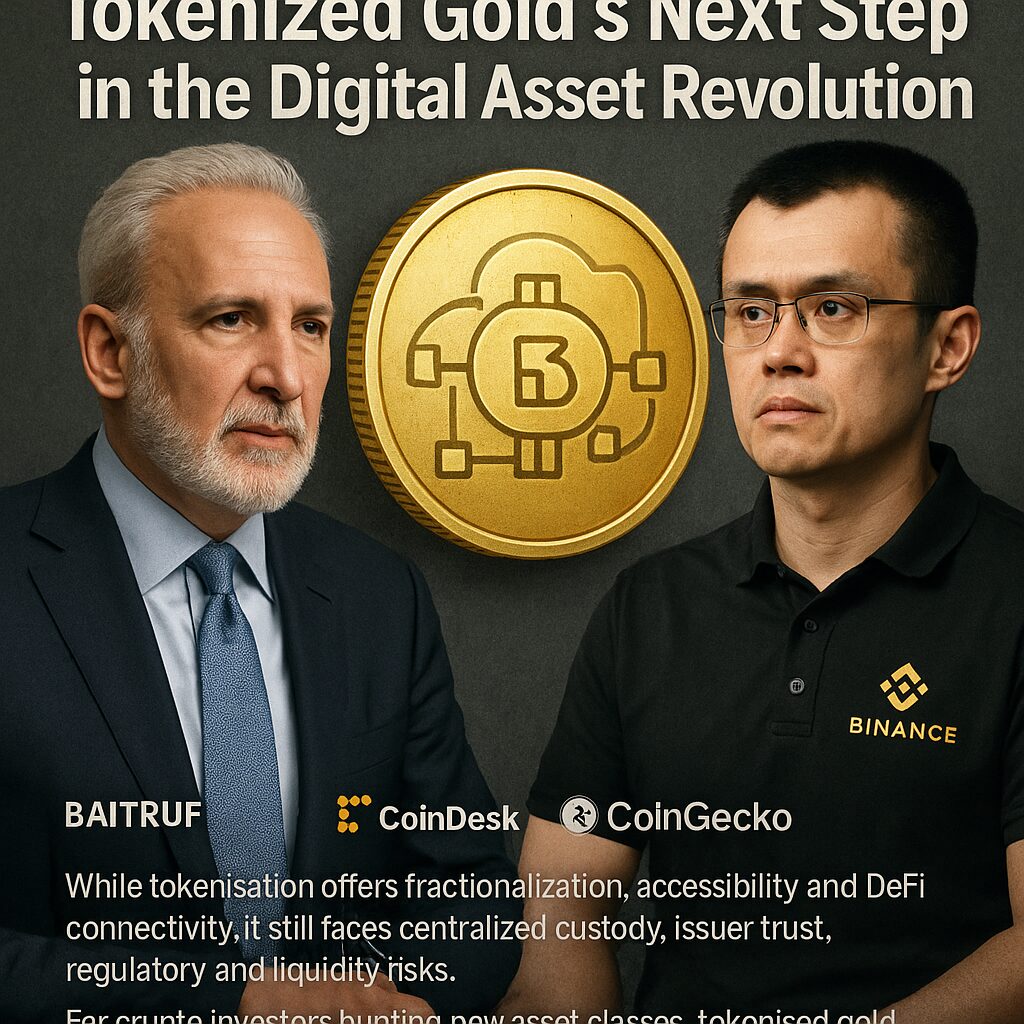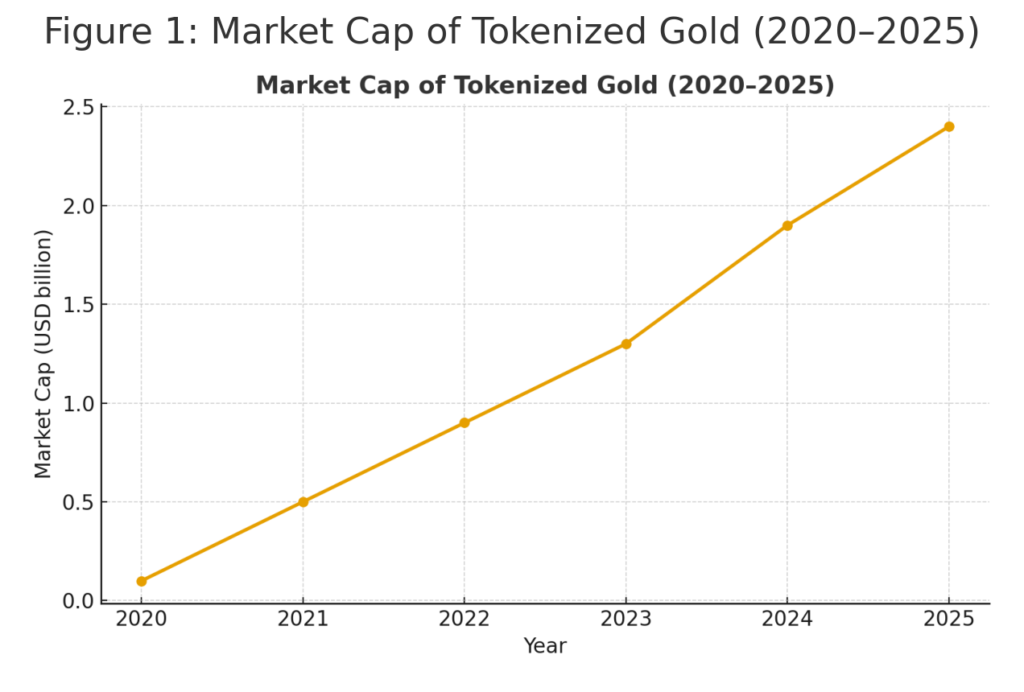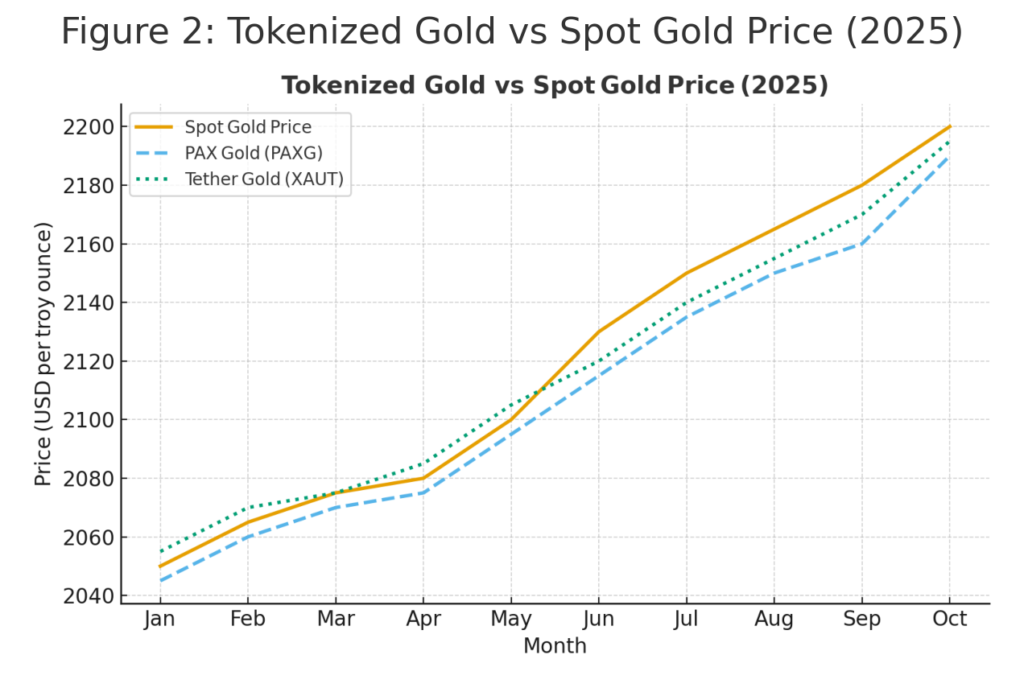
Key Points :
- Long-time gold advocate and Bitcoin sceptic Peter Schiff has announced a new gold-tokenisation platform, positioning physical gold as a bridge into digital finance.
- In contrast, Changpeng Zhao (“CZ”), founder of Binance, challenged the model as merely a “trust-me” token and not a true on-chain asset.
- The tokenised gold sector is hitting milestones: market caps in excess of US$2 billion and trading volumes crossing US$1 billion recently.
- While tokenisation offers fractionalisation, accessibility and DeFi connectivity, it still faces centralised custody, issuer trust, regulatory and liquidity risks.
- For crypto investors hunting new asset classes, tokenised gold straddles the asset-backing model and blockchain innovation — raising the question: is this an income opportunity, a hedge, or simply a digital representation of an old-school asset?
1. Peter Schiff’s Gold Token Gamble
Long known as a vocal critic of Bitcoin and promoter of gold as the ultimate store of value, Peter Schiff has turned his focus to the tokenisation of gold via his company Schiff Gold. According to his recent interview, Schiff’s platform will allow users to purchase gold stored in a vault, tokenise the ownership, and immediately transfer or redeem the tokenised portion.
He describes it as “carrying gold on your mobile phone” and argues that of all assets, gold is the only one that warrants being placed on a blockchain because it already functions as value preservation while leading into digital payments.
This initiative marks a pivot for Schiff: from criticising digital assets to leveraging blockchain for his preferred asset. The rationale: gold remains the anchor, blockchain merely modernises access and transfer. For readers seeking new crypto-adjacent revenue streams, this model signals gold’s entry into tokenised digital finance.
2. CZ’s Critique: “Not Real On-Chain”
In response to Schiff’s announcement, Binance founder Changpeng Zhao delivered sharp criticism, labelling tokenised gold as “not a true on-chain asset”. His core argument: the model still relies on a central custodian or issuer who promises to hand over physical gold at some later point — in essence, a trust-token, not a decentralised bearer asset.
He observed: “It’s a token that says ‘trust us, we’ll deliver gold later’” and argues that such trust-based models are precisely why gold-coins and gold tokens never scaled like pure on-chain assets.
For crypto investors used to decentralised tokens where ownership is self-custodied on the chain, this critique highlights a tension: tokenised assets may offer blockchain wrapper, but remain tethered to off-chain custodians and real-world infrastructure.
3. Market Momentum: Tokenised Gold Hits New Highs
Despite debates over on-chain purity, the tokenised gold market is gaining serious steam. According to CoinGecko, tokenised gold tokens now have a market cap in the range of US$2 billion+.
For example:
- Tether Gold (XAUT) and PAX Gold (PAXG) are among the largest, trading at roughly US$4,070 per token (tied to ~1 troy ounce of gold) and enjoying multi-hundred-million-dollar market caps.
- A report noted that in March 2025 the tokenised gold market cap climbed to US$1.4 billion as trading volumes soared.
- Cointelegraph noted weekly trading volumes exceeded US$1 billion for the first time since the 2023 U.S. banking crisis.
This pace of growth signals that tokenised gold is no longer a niche experiment — it is attracting institutional and retail interest, especially in times of macro uncertainty when gold historically shines.

4. Why Tokenise Gold? Four Practical Levers
For readers actively seeking new crypto assets or yield opportunities, tokenised gold offers distinct features:
a) Fractional ownership and accessibility
Traditional gold often requires purchase of bars or coins, storage, insurance and physical logistics. Tokenisation allows users to hold fractions of a gram or ounce, lowering the entry barrier and enabling use of wallet-based transfers.
b) 24/7 transferability & integration with DeFi
Because the gold-backed token lives on a blockchain (mostly ERC-20/compatible), users can transfer, trade or integrate into DeFi protocols more easily than physical bullion. This brings gold into the digital financial fabric.
c) Bridge between traditional safe-haven and digital finance
Schiff frames tokenised gold as a bridge: the safe-haven appeal of bullion meets the digital infrastructure of blockchain. For investors who believe in both asset-backing and crypto infrastructure, this is appealing.
d) Global liquidity and portability
Tokenised gold may unlock global access; e.g., someone in one country can acquire exposure without needing local bullion trade or vault access, and redeem or transfer tokens rapidly, subject to issuer terms.
5. But: Risks and Limitations to Watch

While promising, tokenised gold carries caveats — especially for the crypto investor looking for “next income source”.
Custody and counterparty risk
Even though the token is on-chain, the underlying gold is stored off-chain in vaults, managed by custodians. The token purchaser still relies on the issuer’s transparency, audits, redemption rights and regulatory cover. As CZ emphasises, it may still be a “trust us” model rather than fully decentralised.
Regulatory, legal and structural risk
Cross-jurisdiction custody, redemption mechanics, issuer compliance and token classification (asset vs security vs derivative) are all complex. Many tokenised gold tokens operate in a regulatory grey zone.
Liquidity & secondary market limitations
While market caps are rising, tokenised gold is still small relative to the global gold market, and trading volumes/liquidity may be lower than investors expect. Some academic work shows gold-backed crypto did not deliver true safe-haven behaviour during COVID-19.
Premiums, redemption friction & issuer transparency
Gold tokens may trade at premiums or discounts relative to spot gold due to fees, custody, trust, redemption terms. Also, actual physical redemption may be limited or costly, meaning the token might not be exactly equivalent to physical bullion ownership.
6. Implications for Crypto Investors Seeking New Yield or Use Cases
From the standpoint of someone looking for new assets or practical blockchain applications, tokenised gold offers interesting angles:
- Diversification possibility: If you already hold crypto native tokens (e.g., Bitcoin (BTC) or Ethereum (ETH)), tokenised gold can offer exposure to a traditional safe-haven asset but with transferability and blockchain access.
- Yield/DeFi integrations: Some platforms may enable staking or lending of gold-backed tokens. If you can deploy tokenised gold into DeFi, you could earn yield while maintaining gold exposure — though you must check counterparty risk.
- Asset-backed narrative: If you subscribe to the “Asset-Backed Representation” side of your Two-Extremes Model (where traditional finance assets are represented digitally), tokenised gold is a textbook example. It meshes finite reserves (gold) with blockchain representation.
- Use-case for payments/settlement: The promise of “mobile gold” (as Schiff phrases) may enable settlement of value across wallets in jurisdictions where gold is already trusted and used. For example, gold tokens could be used as programmable money in micro-payments, cross-border transfers, hybrid crypto-traditional fiats.
- Early adopter domain: While the real world gold market is huge (tens of trillions), the tokenised portion is still small (a few billion). Being early in such an asset class could mean less competition and more upside if adoption accelerates.
7. The Bigger Picture: RWA Tokenisation & Digital Value Bridges
Tokenised gold is part of a broader trend: the tokenisation of real-world assets (RWA) — everything from real estate, commodities, treasury securities, to art. Industry reports project trillions of dollars shifting into tokenised form by the end of the decade.
In that light, the gold tokenisation story may serve as a blueprint: physical asset → token → blockchain ecosystem → integration with DeFi/payment rails. For blockchain practitioners, this raises practical questions: how to build token standards, custody/infrastructure, audits, regulatory compliance, wallet support, cross-chain transfers, collateral protocols. If you’re designing or auditing a non-custodial wallet (e.g., your project ‘dzilla Wallet’), understanding how gold-backed tokens behave (redeem-ability, custody proof, smart contract standards) may offer valuable lessons.

